Steering clear of bad fertilizer
November 16, 2011
 Ah, November. The days are shorter, the light is sharper, and if you breathe deeply, you can almost smell the—whew! Maybe let’s not smell the air today.
Ah, November. The days are shorter, the light is sharper, and if you breathe deeply, you can almost smell the—whew! Maybe let’s not smell the air today.
Yes, fall is fertilizer season in Southern California. And as the autumn air grows pungent over the lawns of Los Angeles County, homeowners are being reminded to spread the wealth responsibly.
“The same nutrients that make your grass grow also will make algal blooms grow if they wash down the storm drains and into the waterways,” notes Susie Santilena, an environmental engineer in water quality at Heal the Bay.
The nitrogen and phosphorus that are so good for plants may contribute to toxic red tides in the ocean and can make algae run wild in freshwater areas like Malibu Creek, creating dead zones as the green scum blocks sunlight and inhibits the growth of other plants and animals, Santilena says.
The algae even wreaks havoc when it dies, because it sucks oxygen out of the water as it decomposes, a process known as eutrophication.
“When you don’t have oxygen in your waterway, your marine life suffocates and you get fish die-offs because there’s no dissolved oxygen in your water,” she says. “And there are aesthetic issues—algae growth can create pond scum, which is just kind of gross to look at in waterways.”
So what to do? It’s tricky, environmental advocates say, because while organic fertilizers such as steer manure and worm castings have advantages that chemical fertilizers don’t share, both can create destructive runoff if they aren’t applied carefully.
Manure tends to adhere to the soil better, so its runoff is less concentrated, but it also can introduce harmful bacteria into the water.
“I have a personal preference for worm castings for multiple other benefits, including environmental impact of production, but they can be overused like the other fertilizers,” says Santilena, noting that worm castings also can be hard to obtain in sufficient quantities for large-scale application.
“It’s how and when the fertilizer is applied that matters most.”
Environmental consultant and master gardener Curtis Thomsen, who conducts the Countywide Smart Gardening program, recommends a half-and-half mix of compost and fertilizer, sprinkled lightly over a lawn that has been aerated.
If you don’t have compost, he adds, there are sites in Los Angeles that offer free mulch that you can shred to make some and low-cost bins can be purchased at Smart Gardening workshops countywide. “The worms smell the organics in it and pull them down, which allows water to penetrate deeper,” he says, adding that compost is especially good for getting nutrients to the roots of thick grasses that tend to thatch. Also, he says, if you add that mixture to your garden plot this fall, it will improve yields, reduce disease in the soil and produce healthier, stronger plants next year.
Meanwhile, Rudy Valenzuela, regional grounds maintenance supervisor for the county Department of Parks and Recreation, notes that the county aerates and fertilizes its park lawns with a commercial chemical blend of nitrogen, potassium and iron that is geared to its sturdy mixture of grasses. He notes, however, that the crews wait until after dark to water and then do it judiciously, turning off the sprinklers after about 15 minutes per station to avoid runoff.
Both approaches keep in mind the need to keep your fertilizer on your own grass. Here are some dos and don’ts from Heal the Bay:
– Do use fertilizer as sparingly as possible, no matter what type you use. Less is more.
– Don’t ever apply fertilizer right before a rainstorm, and never overwater after applying. Too much water will just lift your fertilizer and wash it off.
–Don’t apply to highly compacted or steeply sloped grasses, which also prevent fertilizers from fully soaking into the soil.
–Do consider creating a rain garden, using rain barrels and other containers that will keep rain in your hard and out of the street.
Posted 11/16/11
This run’s not for turkeys
November 16, 2011
If you’re looking for advance justification for that second serving of pumpkin pie this Thanksgiving, the 5K Turkey Trot might be just the ticket. Presented by UCLA Triathlon, the run benefits MADISONS foundation, a nonprofit group that assists parents of children with rare, life-threatening illnesses.
MADISONS provides a support system for families by facilitating communication with physicians and improving informational resources for parents. The organization runs a program called “Connecting Parents,” where parents of children with the same rare disease can meet and interact. It also maintains the M-Power Rare Disease Database, an ever-growing library of medical information updated by experts from UCLA.
The 5K Turkey Trot circles UCLA’s campus in Westwood on Sunday, November 20, beginning at 8 a.m. Registration for the event is $20. For kids, a 50-meter dash will be held in Drake Stadium for $3. Twenty percent of the proceeds will go to MADISONS. Directions to Drake Stadium, where the 5k race begins and ends, are available online.
Posted 11/16/11
We’ve all got a stake in the jail
November 16, 2011
The Men’s Central Jail sits on the edge of downtown, a non-descript structure surrounded by a cottage industry of bail bondsmen. Built mostly during the Kennedy Administration, it’s a deeply depressing place, filled with 4,000 or more men crammed into dank cells.
A good number of them are short-timers—misdemeanor offenders serving just a fraction of their sentences because of the overcrowded conditions. But there are hundreds upon hundreds of others—accused murderers, rapists, drug kingpins and the like—who are incarcerated in the so-called MCJ while they await trial, a process that can sometimes consume years.
Unfortunately, it’s a place where some Sheriff’s Department deputies also have crossed lines of behavior demanded of them in a civil and constitutional society.
As you may have heard or read, Los Angeles County’s sprawling jail system, which includes the more modern Twin Towers Correctional Facility, is under investigation by the FBI because of alleged brutality by deputies who run the operation.
On Friday, a new investigative body, comprised of seven distinguished individuals, will begin its inquiry into excessive force behind the bars. The Citizens’ Commission on Jail Violence was unanimously created by the Board of Supervisors through a motion by Mark Ridley-Thomas and me. The commission was infused with a no-holds-barred mandate to help us understand how a small minority of deputies could poison the culture of an entire institution.
In the hopes of better understanding the challenges ahead for the commission and the Sheriff’s Department, I visited the Men’s Central Jail this week with Sheriff Lee Baca and Captain Ralph Ornelas, who oversees the facility. (See the photo gallery below.) Day in and day out, I can’t imagine a tougher, more menacing workplace, especially for rookie deputies who spend their first 3 to 5 years assigned to the jails—a practice now rightfully being reexamined.
Ornelas, the Brooklyn-born son of a New York cop, was put in charge of MCJ in March. He says he’s determined to be a force for change, inspiring a fundamental shift in the way his charges approach their jobs. “It’s about brains, not brawn,” he tells the deputies. “Let’s be more cerebral, more sophisticated, more professional.”
He says that when deputies resort to force too quickly, they’re not only unnecessarily escalating situations but undermining their own effectiveness today and in the future when they’ll be in patrol cars. “You have to develop your people skills, think through problems. It’s about verbal tactics. This way, you become a more confident deputy, who can solve problems.”
“The deputy in the jail,” he preaches, “becomes the deputy on the streets.”
I wish Ornelas and the Citizens’ Commission much success in their parallel missions because the stakes could not be higher—not just for the inmates and deputies but for all of us.
In the months ahead, thousands of new inmates will be entering our jail system thanks to a monumental shift of responsibilities in California’s criminal justice system called realignment. As of October 1, inmates convicted of certain non-violent, non-serious, non-sexual crimes that used to get them a stay in one of California’s 33 prisons, are now being sentenced to county jails.
Virtually overnight, the management of our lockup has become immensely more complicated, requiring daily decisions about which inmates should be freed earlier to clear space for the arrivals. The implications for the safety of our neighborhoods are enormous.
So while it may be easy for some to dismiss the pain inflicted on inmates by their jailers, it’s important to remember that what happens inside that difficult place can affect each and every one of us. Every facet of the facility must be operated with precision and professionalism. The jail may be located on a small, obscure street named Bauchet, but this is one problem that’s in everyone’s backyard.
Photos by Henry Salazar/Los Angeles County
Posted 11/16/11
Need bike parking? No sweat
November 16, 2011
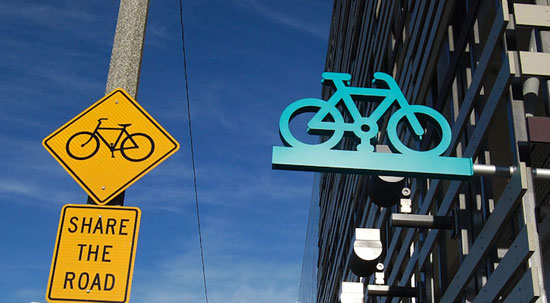
Santa Monica's new Bike Center is a sign of the times, offering new resources to folks who cycle to work or play.
Portland may get all the bicycle buzz, but Southern California cyclists can lay claim to some bragging rights, too, as Santa Monica on Friday opens what’s billed as the largest bike parking facility in the country.
The Santa Monica Bike Center will provide cyclists with secure bike storage, rentals, repairs and more. The ribbon cutting ceremony will take place Friday, November 18, at 10 a.m., and will be followed by open houses from 11 a.m. to 5 p.m. on Friday, Saturday and Sunday.
Up to 260 regular customers can reserve personal locking stations and showers for $15 monthly or $99 annually. Lockers and towels will be available at additional cost. (See the website for full membership details, including 24/7 access to the secure bike parking area.)
For all users and visitors, the center will provide other services like bike and Segway rentals, retail supplies, self-service air and repair station, and a “bike valet”—just drop off your wheels and they will be safely stored under supervision.
The center will also be used for special events, cycling classes and bike tours, all part of a plan to show people the upside of choosing transportation that is greener, healthier and, in many cases, just as fast as driving.
“InSanta Monica, a bike is really time-competitive with a car for most trips,” said Lucy Dyke, deputy director for special projects for the City ofSanta Monica. “Our streets are very congested.”
Josh Squire, CEO of Bike & Park, which operates the Santa Monica Bike Centerand others like it nationwide, said it is the highest-capacity bike parking facility in the country.
The bike center is located at Colorado and 2nd Street—next to the future site of the Expo Line’s westernmost station. The light rail line eventually will connect downtown L.A. to Santa Monica. Phase 1 is nearing completion, and an initial segment—from downtown to La Cienega/Jefferson—is expected to open early next year. (Check out this guided video sneak preview with Supervisor Zev Yaroslavsky.) Phase 2, which broke ground in September, will extend the line from Culver City to Santa Monica.
The Los Angeles County Metropolitan Transportation Authority partnered withSanta Monica in 2007 to create the $2 million dollar bicycle transit hub. Metro funded $1.5 million and Santa Monica pitched in the remaining $500,000.
Posted 11/16/11
Saluting veterans in every way
November 9, 2011
This Friday, November 11, Los Angeles County joins the nation in lauding the military men and women who’ve served our country. Ceremonies, parades and other special offerings are planned to honor current and past members of the armed forces.
Veterans Day events ranging from solemn to festive will give onlookers a chance to reflect on the importance of military service and to remember those who have passed away. Among the observances is a community ceremony at 11 a.m. at Forest Lawn’s Memorial Park in the Hollywood Hills, featuring music, skydivers and a military vehicle display. Also at 11 a.m., Malibu pays tribute in Legacy Park with remarks from veterans, a U.S. Navy flyover and a parade of colors courtesy of Pepperdine University’s Reserve Officers Training Corps.
In the San Fernando Valley, the annual parade begins at 11:11 a.m., departing from San Fernando Mission Boulevard and Laurel Canyon Boulevard and ending at Ritchie Valens Recreation Center and Park in Pacoima, where a street carnival will be held.
Beyond the parades and formal observances, recreational possibilities include a special deal from the L.A. County Department of Parks and Recreation, which is offering half-off greens fees at all county-operated golf courses for veterans with proper ID. In Long Beach, the Aquarium of the Pacific will offer free admission to veterans, military, police and firefighters.
In addition to local discounts and deals, national corporations are increasingly organizing holiday promotions to honor and benefit veterans as well. From cereal companies to restaurant chains to home improvement stores, brands are offering freebies and discounts to veterans, and in some cases are donating to nonprofit support organizations including the Wounded Warrior Project and the United Service Organizations (USO).
The L.A. County Department of Military and Veterans Affairs has compiled an extensive list of special offers and observances across the county this Veterans Day.
Posted 11/9/11
Dancing on flower power
November 9, 2011
Donna Sternberg & Dancers is a Santa Monica-based group that likes to rustle a few leaves. This Sunday, they’ll take their site-specific, eco-conscious dance style to the Baldwin Hills Scenic Overlook.
“The Flowering of Desire” is the first in a series of performances devoted to the idea of desire in the plant world—the allure of flowers, the sweetness of fruit and procreation by spreading seeds and pollen with wind, animals and insects. Live music will be provided by composer and motorcycle enthusiast Ken Christianson.
The performance also seeks to connect dance and science. Margot Griswold, an Audubon ecologist, will talk about the natural setting of the dance, now restored after years of oil drilling and neglect.
This free event is sponsored in part by the Los Angeles County Arts Commission, and takes place Sunday, November 13, at 3:30 p.m. Baldwin Hills Scenic Overlook is located at 6300 Hetzler Road in Culver City. Take a short hike after the show and you might just catch the setting sun from the lookout point.
Posted 11/9/11
California, by design
November 8, 2011
Lots of art isn’t found in museums, galleries or collections, but in things we see and use in our daily lives. Learn how California artists helped shape our world as the Los Angeles County Museum of Art presents “The Legacy of the California Design Exhibitions: Creating a Forum for Craft and Design” on Saturday, November 12.
The free, day-long program features documentary screenings, interviews and panel discussions with artists and curators of the influential California Design exhibitions, held at the Pasadena Art Museum from the 1950s to 1970s. These exhibitions are being revisited now in LACMA’s California Design, 1930-1965: “Living in a Modern Way.” It’s part of the massive “Pacific Standard Time” initiative taking place in many venues around the county.
One of those venues is the Craft and Folk Art Museum, just down the block from LACMA, which offers a peek at California artists’ influence on crafts in a companion exhibit, The Golden State of Craft: California 1960–1980. Also on Saturday, the museum is hosting “Wired Up,” an educational event where participants can see how wire was used in the objects on exhibit, and try their hand at creating wire sculpture themselves. Admission is $5.
The LACMA design forum runs from 9:30 a.m. to 4 p.m., and Wired Up is from 12:30 to 2:30 p.m. LACMA is located at 5905 Wilshire Boulevard, and the Craft and Folk Art Museum is at 5814 Wilshire Boulevard.
Posted 11/8/11
Gaga for night trains
November 8, 2011
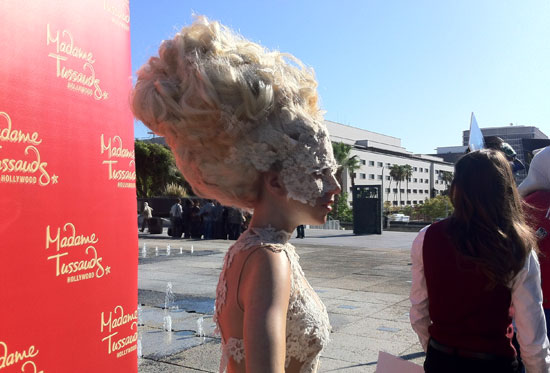
A faux Lady Gaga and a contingent of real celebs showed up to promote Metro's new ridership initiative.
Whether your taste runs more to seeing an incredibly lifelike Lady Gaga at Madame Tussauds or to swimming with sharks at the Aquarium of the Pacific, Metro has a holiday season gift for you—more frequent night trains to popular Los Angeles County destinations starting Sunday, November 13.
Metro’s board chair, Los Angeles Mayor Antonio Villaraigosa, announced today that the agency’s busiest rail lines—the Red and Purple line subways and the Blue Line light rail—will be stepping up their service between 6 p.m. and midnight. Trains will run every 10 minutes or so—double the current frequency—thanks to a trial program that involves running shorter trains more often.
If it’s successful, the program may be extended to other lines next year.
The night trains were announced at a news conference at the Music Center attended by representatives of arts, sports and entertainment venues—including a teenaged cellist and violinist from the Colburn School, a scuba-suited aquarium board member and the L.A. Kings’ mascot, along with that realistic Lady Gaga mannequin.
The new night service coincides with a series of discounts being offered at an array of participating venues. (Click here for more information.)
To make sure the trains are safe, Villaraigosa said more sheriff’s deputies have been brought in recently, and added that crime on the system overall has declined about 5%.
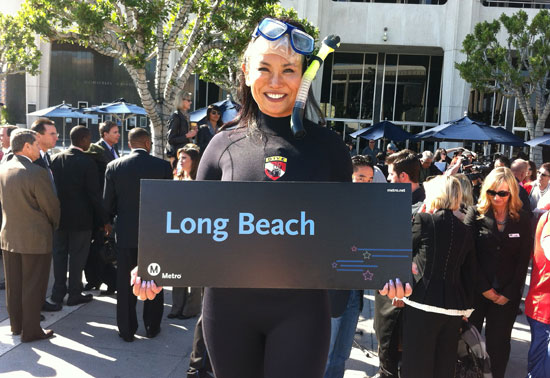
Patricia Wang of the Aquarium of the Pacific in Long Beach encourages night visits via the Blue Line.
Posted 11/8/11
Test driving Expo Line, 11/11
November 6, 2011
As the Exposition Light Rail Line rolls closer to becoming a reality, Supervisor and Metro Board Member Zev Yaroslavsky recently hopped aboard one of the test runs. Early next year, trains are expected to run from the 7th Street Metro Center downtown to La Cienega and Jefferson. Meanwhile, construction will continue on Phase 1′s westernmost station in Culver City. Eventually, Expo Phase 2 will extend to 4th Street and Colorado Avenue in Santa Monica. When it’s complete, the 15.2-mile line will be the first mass transit rail project on the Westside since the Red Cars.
Posted 11/06/11





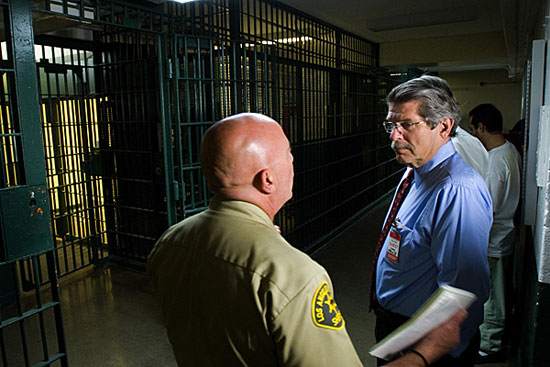











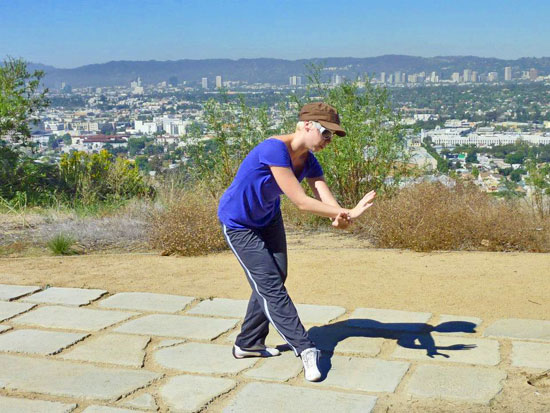
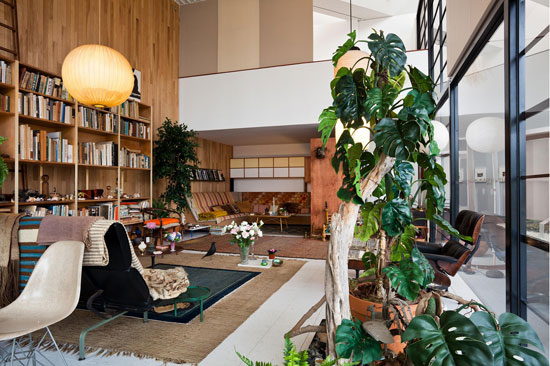





 Check for the latest closure information
Check for the latest closure information








